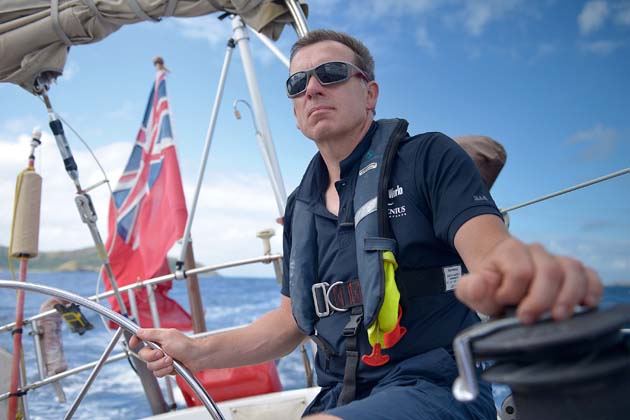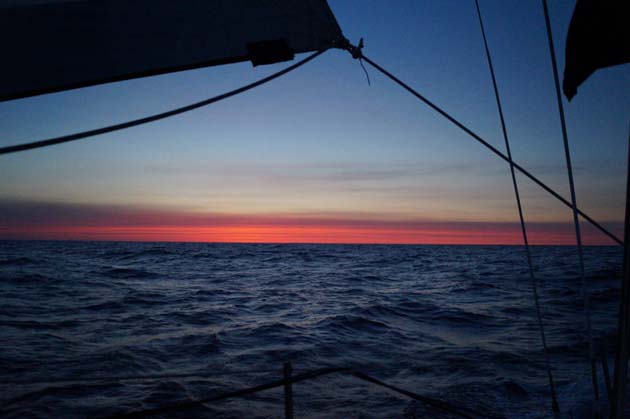A yacht runs best on passage when daily tasks and watchkeeping are well-organised and understood by all the crew, says Dan Bower. This is particularly important at night
 You know when you’re into an ocean crossing when life on board blends into one easy experience – watches, meal times and days are all a blur. Knowing the date becomes important only when playing with a sextant or for working out how many days you have been at sea.
You know when you’re into an ocean crossing when life on board blends into one easy experience – watches, meal times and days are all a blur. Knowing the date becomes important only when playing with a sextant or for working out how many days you have been at sea.
Choosing a watch system and routine that works for your crew and their experience is really a matter of personal taste, and many ocean planning books give examples to work from. Our key factor is our crew numbers, which are usually made up of eight, two professionals and six crew who range from Yachtmaster to novice. We also hand steer the boat except at meal times, which increases the physical requirements, and all crew partake in the domestic duties.
Setting up a system
When choosing a watch system we think it is important that:
- There is a decent handover period – at least long enough to drink a cup of tea. The new crew can be awake and properly briefed on boats around, wind patterns, squalls and standing orders (when to wake the skipper). A clear format should be adopted for a handover and it’s both the oncoming and outgoing crew’s duties to remember that standing orders need to be exchanged.
Our criteria always include maximum wind speed, minimum boat speed, desired course and allowable course alterations. Crew don’t always like ‘disturbing’ you if they think it’s unnecessary so without this structure, with unfamiliar crew it’s possible to find yourself coming on deck after a nice snooze to find the wind gusting 30 knots, under full sail and the crew boasting they just hit 15 knots on a surf and isn’t it fun!
Equally you may find yourself wallowing around in no wind going nowhere, when the engine should have been on hours ago.
- Single watches should be no more than three hours at night. Any longer than this on your own at night and you’ll be getting tired and ready for a break.

- The watch system should rotate, so crew do different watches every day. A tropical sunrise is a beautiful thing and it’s nice to see different times of the day. Giving someone 0100-0400 every day is a bit harsh and the midday watch can be unpleasantly hot.
- Organised watches should continue throughout the day, as someone should always be on duty and responsible for keeping a look-out. The bigger the crew, the more important this is.
- If crew numbers allow – and particularly with inexperienced crew – the skipper should be out of the watch system. This means he/she can be called upon at any time to oversee a reef, be on deck for squalls and have time for routine checks and maintenance, and the other host of tasks that usually require attention, including giving tuition to others and even standing in occasionally for a sick crewmember.
If the skipper is to be in the watch system, the mate or next most able should follow on. This allows the skipper to get a good rest knowing the boat is in safe hands. The first few hours of sleep are the most important and after a few hours of deep sleep they will be alert and on call for the later watches.
A clear duty roster helps. Some boats favour a mother watch where one crewmember is responsible for domestic duties for the day, or even the whole passage – for this they get watch breaks.
Remember it’s not just cooking and washing up that needs to be considered, we also have deck checks, fruit and vegetable sorting, writing blogs, sluicing the cockpit and other regular cleaning tasks.
These are best included in the watch system, as otherwise, depending on the fastidiousness of your crew, they can become neglected; dinner usually turns up, but no one notices the rotting potato that is going to ruin all your fresh provisions.
Rolling watch system
On Skyelark when fully crewed we have a rolling watch system. Each crewmember does three hours on and six hours off, and there are always two people on deck. The watch change times are staggered so there is always an hour handover, which gives the new crew time to wake up before taking the helm. This prevents the late night impromptu crash tack or gybe at watch change!
In this system each person has two watch partners so it’s more social and prevents cliques within the group. It also allows us to balance the experience levels on deck. We choose to have the skipper and mate out of the system; they are on call or around to help with any manoeuvres.
Our cooking rota works with the oncoming 1800 watch cooking the evening meal, and the off-going watch washing up. Breakfast and lunch are informal. Our choice of system is largely driven by a crew of eight.
For longer passages or deliveries and when not on charter, we would always like to have three people on board and, as long as there is suitable experience, we would run three-on six-off with single-person watches, including the skipper and mate, although we would be relying on the autopilot to steer.
Occasionally we do short deliveries (72 hours max) with just two-up, in which case we do four hours on/off in the day from 0600 to 1800 and three hours on/off at night. Autopilot and pre-cooked meals are essential for this and we sail conservatively as we really need two on deck to reef or manoeuvre so these are best done at the watch change.
Daily checks
When at sea it’s not just keeping watches that keeps you busy, you also settle into various routines that involve looking after the boat, cleanliness and preparing the food, which on an ocean passage can keep you fully occupied.
It’s important to take some time each day to look around the boat to identify issues before they become a problem; noticing the loose split pin or nut on the deck can make all the difference and avert potential disaster.
Look for chafe and rigging problems, including missing pins or loose bolts/rivets/shackles. We start at the bow, checking the tack shackle, lower furling system and look up the length of the foil. Moving back to the mast we check split pins, rigging screws, pole fittings, gooseneck and vang attachments and look up at the mast section and shroud tension. Further aft and along the boom, we check for chafe on the reefing lines.
Once a week we do engine and generator checks, battery water levels and look over the quadrant and steering system.
As well as deck checks we also have a look around the inside once a day keeping an eye out for anything untoward such as water in the bilge, and also sort through the fruit and vegetable lockers and fridge. This can be done as part of the watch rota or organised informally with the crew.
They say a well run ship is a happy ship, and making sure everyone knows their role makes things run smoothly.
Do’s and don’ts
√ Do have clear standing orders.
√ Do brief on handover.
√ Do Do carry out daily checks.
√ Do rotate the watch system.
x Don’t allow yourself to get over-tired – sleep whenever possible.
Dan and Em Bower
Dan and Em Bower, both in their thirties, are lifelong sailors. Six years ago they bought Skyelark of London, a Skye 51 by American designer Rob Ladd, built in Taiwan in 1986, and have been sailing and chartering her ever since, making some 12 transatlantic crossings and covering around 60,000 miles.
Part 10: Dinghies and tenders
What sort of dinghy, where to carry it on passage, and how to keep it safe ashore
See videos for all the parts here









